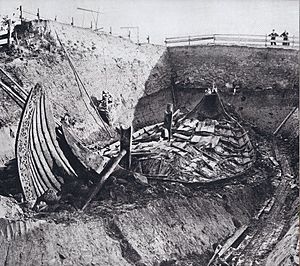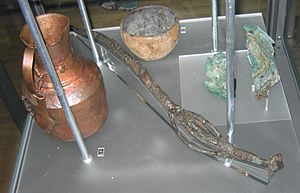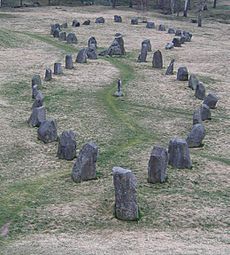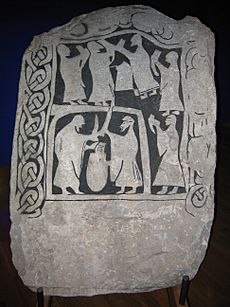Norse funeral facts for kids

Norse funerals were the special ways Viking Age people in Scandinavia buried their dead. We know about these customs from old stories called Icelandic sagas and from things archaeologists have found.
Across Scandinavia, there are many old burial mounds, called tumuli, built for Viking kings and leaders. There are also runestones and other memorials. Some famous places are Borre mound cemetery in Norway, Birka in Sweden, and Lindholm Høje and Jelling in Denmark.
A special tradition was the ship burial. The person who died was placed in a boat or a stone ship. They were buried with special items, called grave goods, that showed their importance. Then, stones and soil were piled on top to make a mound. Sometimes, people were cremated (burned). But usually, people were buried with items that showed their place in society.
Contents
Grave Goods

It was common to bury gifts with the person who died. Both men and women received these grave goods. Sometimes, a Norse person was even buried with a loved one or a house servant, called a thrall. Or, they might be burned together on a funeral pyre.
The number and value of these items depended on the dead person's social group. It was important to bury the dead correctly. This was so they could join the afterlife with the same social standing they had in life. It also stopped them from becoming a lost soul wandering forever. The grave goods had to be treated the same way as the body to go to the afterlife.
A servant's grave was likely just a simple hole in the ground. They were probably buried to make sure they didn't bother their masters later. Also, they might be useful to their masters in the next life.
A free man often received weapons and riding gear. A skilled worker, like a blacksmith, might get all their tools. Women were buried with their jewelry and tools for household tasks. The most amazing Viking funeral found so far is the Oseberg Ship burial. This was for a woman, possibly a queen or priestess, from the 800s. These grave goods showed importance and also special moments in a person's life. For example, many arrows could show how good someone was in battle.
Some experts think grave goods also helped families avoid arguments about who inherited what. Burying valuable items might have helped share out wealth. This could explain why Viking burials often had things that were hard to sell quickly.
Viking funeral customs changed a lot as Vikings traveled to new places. They were influenced by new cultures. For example, jewelry with animal designs was common everywhere. But some items, like Christian crosses, started appearing in burials as Vikings met new religions.
Funerary Monuments
A Viking funeral could be very expensive. But the burial mound and grave goods were not seen as wasted. They honored the person who died. The mound also showed the high social position of their family. Powerful Norse families could show their importance through huge grave fields. For example, the Borre mound cemetery in Norway is linked to the Yngling royal family. It has large mounds that once held stone ships.
Jelling, in Denmark, is the biggest royal memorial from the Viking Age. Harald Bluetooth built it for his parents, Gorm and Tyra, and for himself. It was one of two large mounds with a special burial chamber. Both mounds, the church, and the two Jelling stones show how important it was to mark death with rituals. This was true during pagan times and early Christian times.
In three places in Scandinavia, there are large grave fields used by whole communities. These are Birka in Sweden, Hedeby in Germany, and Lindholm Høje in Denmark. The graves at Lindholm Høje come in many shapes and sizes. There are stone ships and graves that are triangular, square, and round. These grave fields were used for many generations by people living in nearby villages.
Rituals
Viking funeral rituals changed over time and with different cultures and religions. Even as Christianity spread, some pagan funeral customs remained. Recent finds in England show burials that mix pagan and Christian traditions. This shows how Viking rituals changed as they settled in new areas.
Death has always been a very important time for those left behind. Family life has to change. To help with these changes, people use special ceremonies. These ceremonies help the person who died find peace in their new situation. They also give strength to the living to continue their lives.
Even though Vikings were known for fighting, they also feared death and what came with it. Norse stories include spirits of the dead and undead creatures like revenants and draugr.
Funeral rituals could last for days. This allowed time to prepare the grave. These practices might include long periods of feasting and drinking. There could also be music, songs, chants, and special spiritual experiences. Sometimes, animals were put to rest with the dead. Eyewitness accounts even say women had important roles in these rituals, almost like directing the funeral. These performance-style funerals often happened in the same places. This created a special connection between the ritual and the land for the community. Places like lakes, clearings, or even large trees could be the main spot for these rituals. Funerals were not just about burying one person. They often involved many people and activities.
Ship Burials
Ship burials were usually for very important people. The person was buried inside a ship, which held them and their grave goods. These grave goods were much more fancy than those in regular burials. Also, animal remains, like oxen or horses, were often buried in the ship. Sometimes, people were buried in the ground. Then, stones were placed on top in the shape of a ship. Or, a runestone with a ship carved on it was placed on the grave.
The ships used were often pleasure boats, not ships for travel or war. Some ships might have been built just for a burial. This is because they sometimes lacked features like seats.
Cremation
It was common to cremate the dead and burn the grave offerings on a pyre. Only some burned pieces of metal, animal bones, and human bones would be left. The pyre was built to make a very large smoke cloud. This was believed to help carry the person to the afterlife.
Funeral Feast and Inheritance
On the seventh day after someone died, people celebrated the sjaund. This word meant both the funeral feast and the special drink. The funeral feast was a way to officially mark the death. Only after this feast could the heirs truly claim their inheritance. If the person who died was a widow or the head of the home, the rightful heir could take their place. This showed the change in who was in charge.
Several large runestones in Scandinavia mention inheritances. For example, the Hillersjö stone explains how a woman inherited property from her children and grandchildren. The Högby Runestone tells that a girl was the only heir after all her uncles died. These stones are important records from a time before legal decisions were written on paper. One idea about the Tune Runestone from Norway is that its long writing talks about a funeral feast. It might declare three daughters as the rightful heirs. This stone is from the 400s. It is the oldest legal document from Scandinavia that talks about a woman's right to inherit.
See also
- Death in Norse paganism
- Burial in Anglo-Saxon England



